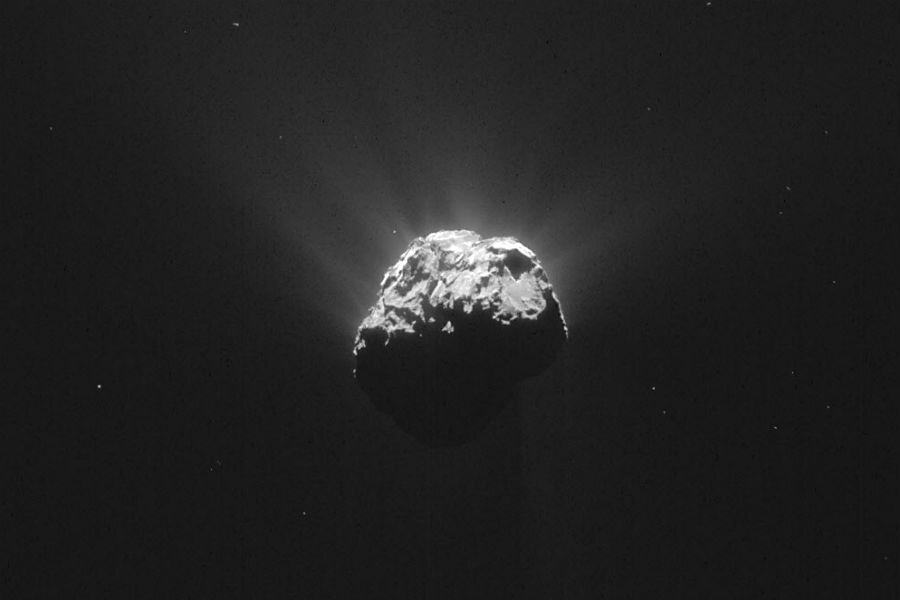Microbes on a comet? Where else might we find alien life?
Loading...
Leading astronomers suggested Monday that microbial life may exist on 67P/Churyumov-Gerasimenko , a comet the European Space Agency has been exploring since it landed a space probe on it last November.
The theory – posited by two leading astrobiologists at the Royal Astronomical Society’s national meeting in Wales today – holds that certain features of the comet, such as its organic-rich black crust, are best explained by abundant microbial life living beneath its icy surface.
The microbes could be similar to the “extremophiles” that inhabit the most inhospitable corners of the Earth, Gretel Kauffman reported for The Christian Science Monitor.
“Computer simulations suggest microbes could inhabit the comet’s watery regions,” wrote Ms. Kauffman. “Organisms that contain antifreeze salts could be active at temperatures as low as 40 degrees below zero, researchers say.”
But if there are living organisms on a distant comet, could there be similar life forms elsewhere in the solar system?
Space agencies around the world believe so, and they are hoping to explore these potential candidates for life in the coming years.
One primary candidate is Europa, the sixth of Jupiter’s 67 moons. The moon is encased in a crust of ice 10 miles deep, but many observers believe the icy crust covers an ocean 62 miles deep that could contain alien life.
NASA is preparing a mission to the moon some time in the 2020s, and the White House’s $18.5 billion budget proposal for NASA earlier this year included $30 million for the agency to develop a mission to Europa, Space.com reported.
In 2012 NASA’s Hubble Space Telescope spotted vapor plumes spewing from Europa’s surface, some reaching 125 miles into the air. Scientists are still debating the frequency and existence of these plumes, but if they do exist, they believe the plumes would provide the easiest way of sampling Europa’s oceans.
According to TechGen Magazine, NASA is tentatively planning for a $2 billion unmanned probe called the Europa Clipper “to measure and map the moon’s ice shell.” The probe would spend eight years travelling to the moon, and then perform 45 fly-bys “at altitudes ranging from 16 miles to 1,700 miles” over three-and-a-half years to analyze the surface of the moon.
The surface temperature at Europa’s equator is still around minus-160 degrees Celsius, but scientists believe there may be underwater volcanoes heating the water beneath the miles of ice, similar to hydrothermal vents on Earth.
“The story of life on Earth may have begun in our oceans, and that’s because – of course – if we’ve learned anything about life on Earth, it’s that where you find the liquid water, you generally find life,” said Kevin Hand, an astrobiologist at the NASA Jet Propulsion Laboratory, in an interview with Space.com.
Other candidates include Mars, Earth’s closest planetary neighbor. NASA’s rover Curiosity has been exploring the planet since 2012, and recently it discovered liquid water beneath the red planet’s surface, a key requirement for alien life.
More distant targets include Enceladus, another ice moon orbiting Saturn, and Titan – Saturn’s largest moon – which is covered in seas of liquid methane. In 2014 scientists discovered a six mile-deep salt water ocean beneath the ice on Enceladus.
Regardless of where it’s found first, the race to discover alien life is very much underway. Europa appears the most realistic candidate at the moment, but with rovers crawling over Mars and comet 67P/Churyumov-Gerasimenko as we speak, the discovery could come at any moment.
The two astrobiologists behind the comet 67P/Churyumov-Gerasimenko theory compared the groundbreaking concept of microbial alien life to the theory that Earth was not the center of the universe.
“After that revolution our thinking has remained Earth-centered in relation to life and biology,” said Chandra Wickramasinghe of the Buckingham Centre for Astrobiology, in an interview with The Guardian. “It’s deeply ingrained in our scientific culture and it will take a lot of evidence to kick it over.”








